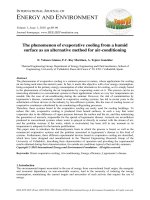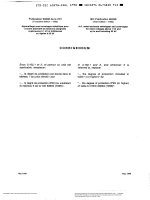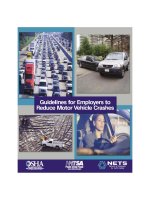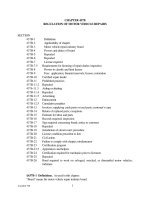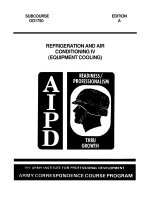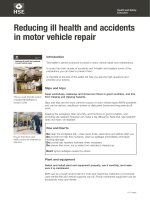A C cycle Motor Vehicle Air Conditioning
Bạn đang xem bản rút gọn của tài liệu. Xem và tải ngay bản đầy đủ của tài liệu tại đây (4.49 MB, 49 trang )
Motor Vehicle Air Conditioning
(MVAC)
System operation and the refrigerant cycle
At Sea level ‐ water boils at 212⁰ F ‐ R‐134a boils at ‐15⁰ F
At Sea level ‐ ‐ R‐134a boils at ‐15⁰ F
At 30 psig ‐
‐ R‐134a boils at 35⁰
F
The Pressure of the evaporator will control it’s Temperature
An R134a temperature‐pressure chart shows what the refrigerant
temperature should be at a specific pressure.
This can be helpful in A/C diagnosis.
MVAC systems that are low on refrigerant will have:
Low pressures in Evaporator (low side) and Condenser (high side)
MVAC systems that are overcharges with refrigerant will have:
High pressures in Evaporator (low side) and Condenser (high side)
__________________ Low charge can
________________
freeze the evaporator
Low charge equals
poor heat transfer
__________________High charge gives
poor heat transfer
at the evaporator
The correct refrigerant charge ensures maximum heat transfer from
the passenger compartment.
Low Side
Absorbing latent heat
turns liquid to vapor
Hi Side
Releasing latent heat
turns vapor to liquid
2 types of MVAC systems
All A/C systems use a compressor, condenser, evaporator
Some systems use the Expansion Valve with Receiver/Drier
Some systems use the Fixed Orifice Tube with Accumulator
Receiver‐Drier
send high pressure
liquid
to expansion valve
Receiver Drier will separate
liquid from vapor refrigerant
Receiver Drier will send
liquid refrigerant (high pressure)
to the expansion valve
Only older R‐12 systems use
the sight glass
Vaporized refrigerant
collects at top of receiver
Receiver drier will have
desiccant bag.
Some desiccant bags
can be changed
Other designs require
component replacement
Liquid refrigerant sinks to
bottom and is sent to
expansion valve
Expansion valve CLOSES when evaporator is too COLD
Expansion valve OPENS then evaporator is too WARM
Expansion Valves sense
evaporator pressure and will
open or close to maintain
ideal pressure/temperature
Receiver ‐ Drier
Some systems use a fixed orifice tube
and Accumulator
Accumulator
Sends low pressure
Vapor to compressor
Used with Orifice Tube
Accumulator will separate liquid
from vapor refrigerant
Accumulator will send Vapor
refrigerant (low pressure) to the
compressor
Accumulator will have desiccant
bag.
Some desiccants can be
changed, other designs require
component replacement
Vaporized refrigerant
collects at top of receiver
and only low pressure vapor
is returned to compressor
Fixed Orifice Tube
Many different types of compressors are used
Most compressors use an electric clutch to cycle compressor
ON and OFF to maintain proper evaporator pressure
Some compressors will not cycle ON/OFF and will
vary the piston stroke to maintain evaporator pressure
Most Clutches are checked using a feeler gauge.
Adjusting Shim
Coil ‐ Magnet
Compressor
Spring loaded Clutch Plate
Drive Pulley

